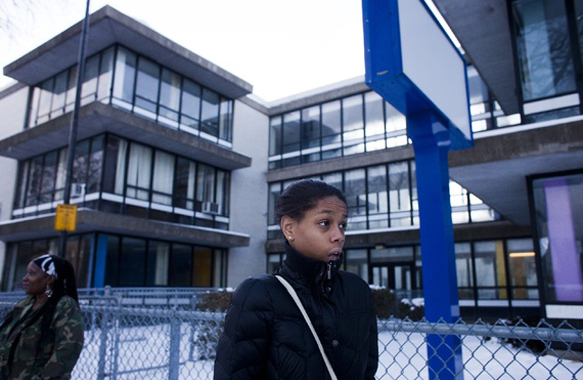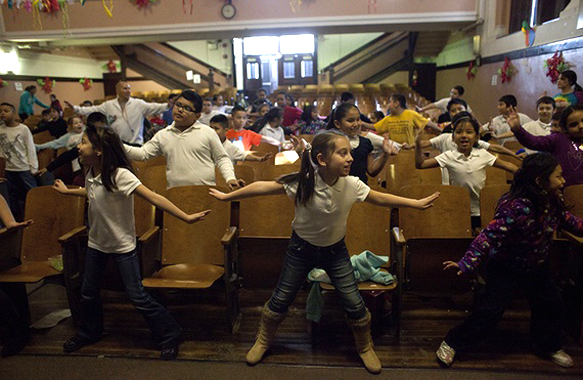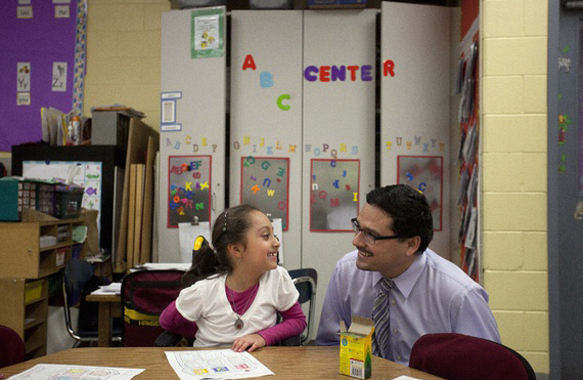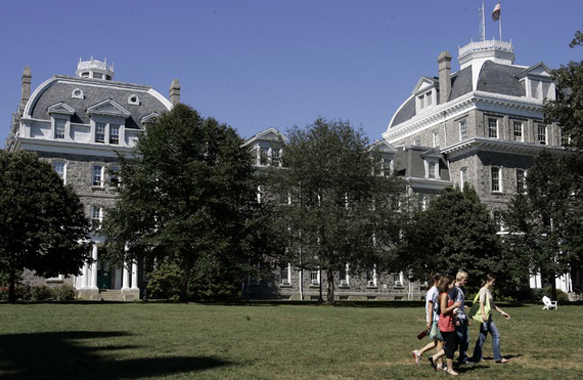Photograph; Second graders at Patrick Henry Elementary School follow along to an exercise video during indoor recess. Recess was made mandatory in Chicago elementary schools when the school day was lengthened in 2012. (Armando L. Sanchez / Hechinger Report)
By Sara Neufeld | Originally Published at The Atlantic. January 21, 2014
Chicago’s new plan to keep kids in school longer has been challenged by budget cuts and safety concerns.
Rahm Emanuel vowed in his successful 2011 mayoral campaign both to increase the amount of time Chicago’s students are in class and to give them a well-rounded education during their additional school hours. And by the fall of 2012, the former chief of staff to President Barack Obama had lengthened the day and year for elementary and high schools alike. Despite a budget crisis, he came up with funds to begin delivering on the second half of his promise. Schools, he said, should not have to choose between offering math or music.
But less than a year later, the estimated amount of the Chicago Public Schools’ deficit, caused largely by a crisis in pension funding, had hit $1 billion. Today, the country’s third-largest school system is still giving its 400,000 students more time to learn, but it is no longer giving more money. In fact, it is operating with fewer teachers and support staff than it was before the longer day began.
“Funding is not there for a quality day, period, no matter the length,” said Wendy Katten, director of the advocacy group Raise Your Hand and mother of a fifth grader at Augustus H. Burley School.
The longer time amounts to elementary students being in school an extra hour and 15 minutes per day, high school students having an extra half hour, and everyone attending for 10 additional days. Within certain parameters, principals have the freedom to decide how to use the added hours. Still, much criticism focuses on the one-size-fits-all nature of the policy in a city with diverse needs. Some students in wealthy neighborhoods and at academically selective magnet schools were already overextended with extracurricular activities. At the elite Whitney M. Young Magnet High School, administrators simply added a study hall. In violence-ridden communities, meanwhile, a later end to the regular academic day has left families worried about their kids getting home safely after dark if they stay to participate in after-school programs and sports.
During his freshman and sophomore years, back when school let out at 2:31 p.m., Raul Arias played basketball and ran cross-country at the Marine Math and Science Academy. “I stopped last year as soon as the whole extended school day started,” said Arias, 17, a senior. He commutes an hour each way on public transportation to attend the military-themed magnet school instead of a subpar option in his neighborhood. “I have to worry more about myself going home than what I’ll actually be doing in school.” While Arias said he has to be vigilant about his safety at all hours, “in the night is when everything happens. That’s when more people get jumped or robbed or all the other stuff.”

Irene Robinson (left) waits with granddaughter Akilra Roberts for the bus. Because the bus only runs at the beginning and end of the regular school day, Akilra has trouble getting home from after-school activities. (Armando L. Sanchez / Hechinger Report)
In his campaign victory speech, on Feb. 22, 2011, Emanuel said, “We have not won anything until a kid can go to school thinking of their studies and not their safety.” Chicago school officials say they have not seen participation numbers drop in after-school activities since the lengthening of the regular day, but they take concerns about student safety getting home seriously.
Last night, school system officials announced that they will use $21.5 million in surplus tax increment financing funds to hire an additional 84 art teachers and 84 physical education teachers, some of the positions recently cut. The move comes as the city’s board of education is scheduled to vote Wednesday on a plan to mandate daily physical education for all students, a state requirement with which Chicago has been out of compliance.
Educators and advocates say daily physical activity for students is a great idea—provided schools receive money for staffing, and there have been widespread concerns they will not. Even with the new money, schools will be responsible for covering a portion of the new teachers’ salaries themselves and in time will need to absorb the cost completely.
Beth Swanson, Emanuel’s deputy overseeing education, said the mayor remains committed to finding more resources for the arts and other enrichment activities. Regardless, she said, more time for reading and math was sorely needed. The longer day has typically brought more time in reading and math as educators are rolling out the new national Common Core education standards and preparing for a switch to more stringent standardized tests.
“On average, kids across the country were getting two additional years of education if not more in their K-12 time period than our kids,” Swanson said. “It just became a real issue of equity in that Chicago’s students would never be on the same footing as other kids across the country… We saw it as a fundamental building block to many other reforms.”
Many smaller districts have lengthened their instructional days and other big cities have expanded time at selected schools, particularly those serving the most impoverished children. The Chicago initiative stands out for its scope, and advocates of more learning time praise Emanuel for taking a stand on a critical issue, even if things aren’t immediately running smoothly. “It’s so difficult to do what he did,” said Jennifer Davis, president of the National Center on Time and Learning. “It’s virtually never been done across the board. I still feel he did the right thing for kids. You have to strengthen it over time.”
Until the 1970s, Chicago students went home for lunch during a long break in the middle of the day. Elementary schools also had a short morning recess and another in the afternoon. All that ended in response to mothers’ changing work schedules alongside a rise in street violence, veterans of the system say.
Schools adopted “closed campus” policies, and schedules were shortened to keep everyone indoors as much as possible. Elementary teachers’ lunch was technically scheduled for after student dismissal, and classes let out early enough to ensure students could get home during the daylight.
And that’s how Chicago’s elementary schools came to have an instructional day of five hours and 45 minutes, compared with a national average of 6.5 hours.
Through the years, violence has continued to plague Chicago. So have stubbornly low achievement levels—something a notably short school day did nothing to help. High schools were in session longer, seven hours a day, but also had a longer lunch break. Citywide, students went to school 170 days a year, compared with the standard American 180—and 240 in Japan.
When Emanuel began promoting plans for more time in school, parents expressed support. But how much time was the right amount? People could agree that the status quo was too little, but particularly given the budget shortfall, how much was too much?
In April 2012, the coalition released a report called The Best Education, or Just the Longest? It detailed concerns that children were not receiving a well-rounded education, with high emphasis on test prep, particularly at the lowest-performing schools. It also advocated for more social and emotional interventions, better early childhood education, and lower class sizes in the early grades. “Providing more time to repeat activities that are failing will not benefit our children,” it said.
Emanuel scaled back his plan slightly, to a seven-hour day for elementary schools. High schools would have a 7.5-hour day, and the academic year would be 180 days.
At Ray Elementary in President Obama’s old neighborhood of Hyde Park, librarian Leslie Travis wondered when the plan became public how the additional time would benefit children there given the large class sizes. Back then, “we had 43 children in each of our kindergarten classes, with one teacher and no aide,” she said. “The idea that we were going to have
Travis, who retired last spring after 35 years working in education, said Ray’s kindergarten class sizes have declined somewhat but remain far too big. “There are many classes that are still enormous throughout the city,” she said. “The longer school day was a well-intentioned idea that was put together with the logic of someone who’s trained in economy and business but not as an educator: ‘You have more time, you get more results.’ That’s not necessarily what ended up happening.”
In September 2012, what happened was a teachers’ strike, spurred partly by the fact that teachers were being asked to work more without a proportionate pay increase. Chicago’s schools were closed for seven days.
Under the deal that allowed operations to resume, elementary teachers would be at work for more hours, but with a substantial midday break for lunch and planning. Students, too, would have longer for lunch. Recess—which can improve students’ concentration, socialization and physical activity levels—was back, with principals to figure out staffing. And the system would hire new teachers, many in art, music and physical education, as principals decided within the contract’s terms how their schools could best use their additional time and resources.
Indeed, budget documents show that last academic year, Chicago Public Schools allocated money for 762 more teachers than in the 2011-2012 school year. School system officials said 511 of the new positions—many in art, music and physical education—were created specifically to help elementary schools with the longer day, but not all of them were filled. High schools did not receive additional staff automatically since they were not adding as much time.
This year, 1,413 teaching positions—6.5 percent of all those in the city—were cut. So were 1,927 school support positions, nearly 15 percent of all the clerks, aides and others who help make teachers and administrators’ jobs manageable.
Many schools have seen class sizes swell, alongside a decline in counselors, librarians, and reading and math intervention teachers.
Theodore Roosevelt High, on the city’s northwest side, lost $1.6 million—about 10 percent of its budget. Seventy-five percent of the school’s nearly 1,400 students are Latino, and 97 percent receive free or reduced-price lunch.
The cuts meant losing the attendance clerk, who helped track down truant students, and the college and career coach, leaving teachers to help with financial aid forms and college essays. Teachers say the in-school suspension program no longer has a designated staff person to monitor students, many of whom just get up and leave. Roosevelt has cut back on its night school program and eliminated many elective courses, including the student newspaper.
To make use of its additional time, the school added five minutes to every class period. Social studies teacher Tim Meegan said he sees students cutting the last period to get to after-school jobs or pick up younger siblings.
“My pacing has been the same. I haven’t been able to get further ahead in the curriculum,” said Meegan, who holds the prestigious National Board Certification and has been at the school for a decade. “There’s no way anyone can tell me kids are learning more because they’re in school longer.”
As Roosevelt administrators try to boost test scores, many students now attend two periods a day of English and another two of math in lieu of motivating electives. “The promise was opportunity, and it’s double-period English and double-period math,” said Keith Plum, an English teacher and the school’s union delegate. “How are they going to be interested in school? I mean, really, how?”
To show a school where the longer day is having a positive impact, the Chicago school system’s communications office pointed me to Patrick Henry Elementary, which also serves a predominantly Latino, low-income population in the northern part of the city. (The office denied my request to visit another elementary school near Henry that has experienced deeper budget cuts.)
Henry saw its enrollment increase this school year, and much of the $200,000 cut from its budget in the spring was consequently restored, since funding is based on the number of students. The school is still operating without a teacher to support students learning English as a second language and their families, and it now has a part-time reading intervention teacher rather than a full-time one. The music program was cut, but physical education, health, computers, library, and art remain.
Principal Januario Gutierrez, a congenial father of five, has assembled a team of highly driven teachers willing to work far longer than even the extended day requires. Scores have steadily been rising.
Older teachers with families tend to burn out on such long hours, but Diane Meloscia, who also teaches third grade at Henry, has worked this way for years. With three kids and a grandson at home, Meloscia leaves earlier than Nunn, but she said she grades papers and plans lessons late into the evenings and sets her alarm for 5:30 a.m. on weekend mornings to get work in before her family gets up. She said her hours outside school have increased recently because of the more rigorous Common Core standards, not the longer day. “As long as our students need us as much as they do, we will continue working the long hours regardless of the [time] the kids are in school,” Meloscia said.
Gutierrez, the principal, seems to have successfully navigated a new terrain that has been highly problematic for many of his colleagues: recess.
The teachers union contract prohibits principals from asking classroom teachers to supervise recess, which is now mandatory for Chicago elementary schools despite the fact that a quarter of them do not have playgrounds and cold weather often requires staying indoors. The situation has left numerous principals asking other staff members to step in—including counselors with overbooked caseloads—or scrambling to hire outside contractors to supervise what in the winter often becomes indoor socialization, typically with students sitting in an auditorium.
At William P. Gray Elementary, a school that experienced $1 million in budget cuts this year, Principal Sandra Carlson said she had to find $95,000 this year for a contractor to supervise recess. She has not had luck using parents for the job, but that strategy is working at Henry for Gutierrez, who pays three mothers a total of $21,000 for the year.
It’s too soon to say whether the longer day has affected student achievement in Chicago. City and school officials have brought it up while discussing improved attendance and graduation rates and a decline in the city’s murder rate last year, as well as in highlighting the positives in mixed test results.
The community groups that organized around the longer day last spring turned their attention to opposing plans for dozens of school closures. Fifty buildings, primarily in crime-ridden areas, were shuttered amid massive protests. Students were relocated to other schools, often still in their neighborhoods but not as close to home as before.
That also had implications related to the longer day: Since busing is only provided at the end of regular school hours, students must choose between after-school activities or finding their own way home. And with school dismissing later, after-school activities often run until after dark.
“A lot of them are walking home, which is very dangerous,” said Jeanette Taylor, a mother who chairs the local school council at Irvin C. Mollison Elementary, which absorbed students from Anthony Overton Elementary when it closed.
Akilra Roberts, 12, has to miss cheerleading practice most days at Mollison because her grandmother, Irene Robinson, has no one to pick her up and won’t let her walk the mile alone. Robinson said her granddaughter’s behavior is deteriorating as she is losing the thing she cares most about school.
Jadine Chou, the school system’s security chief, has a staff that works with students and families to develop individual safety plans outlining transportation specifics, whether getting a ride from another student’s parent or traveling in a group.
“The longer school day has helped us in keeping our children in schools,” she said. “We believe strongly it has been a safe haven for kids in our city.”
This story was produced by The Hechinger Report, a nonprofit, nonpartisan education-news outlet affiliated with Teachers College, Columbia University.















Leave A Comment